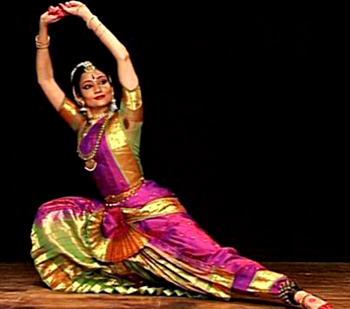 Tillana is the final section of Bharatnatyam in the Nritta section.Genius music is presented through the footwork and enchanting poses of the dancer. The statuesque nature of the dance style is dominant in the Tillana. By this time the dancer reaches a degree of flexibility in movement that she attempts to reinforce throughout her recital. She fully develops here what she introduced in Alarippu. She starts with eye movements then shifts to the neck and proceeds to the shoulder movements. Thereafter there is a display of several standing postures which include the leg extensions and the ardhamandali positions.
Tillana is the final section of Bharatnatyam in the Nritta section.Genius music is presented through the footwork and enchanting poses of the dancer. The statuesque nature of the dance style is dominant in the Tillana. By this time the dancer reaches a degree of flexibility in movement that she attempts to reinforce throughout her recital. She fully develops here what she introduced in Alarippu. She starts with eye movements then shifts to the neck and proceeds to the shoulder movements. Thereafter there is a display of several standing postures which include the leg extensions and the ardhamandali positions.
All types of rhythms are used here. The dance cadences are designs of straight lines, triangles, semi-circles and diagonals. The araddis are highly emphasized here. Finally, the dancer ends her recital either by concluding araddis or by a quick exit in uromandala hasta. Most dance recitals now end in the final sloka in Sanskrit. The Nritta portion ends in the finale of the Tillana, the abhinaya portion ends with the sloka invoking god in his peaceful mood.
Many changes and improvements have taken place since the fifties. Musical compositions which have been used for the dance are more interesting. The repertoire has been enlarged and the sequence has changed. The navasandhi and the sloka are more popular and less prominent Jatisvaram, varnam and Tillana have been introduced.
Bharatnatyam continues to be vital even today because it has witnessed revitalization by either reviving older forms or by introducing new forms. Repertoire in Bharatnatyam has inevitably seen changes.
This article is a stub. You can enrich by adding more information to it. Send your Write Up to content@indianetzone.com



















